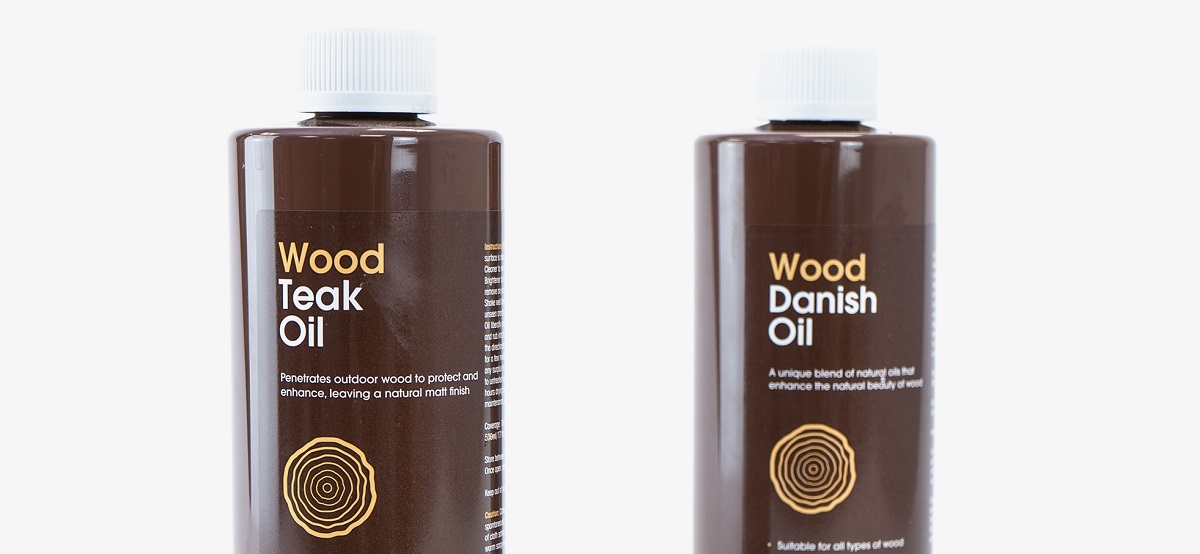-
You have no items in your shopping cart.


They are both wood oils designed to soak in, protect, and enhance wooden surfaces. They both work on indoor wood such as furniture, flooring and cabinetry and they also both work on outdoor wood such as garden furniture.
There are still differences between these two wood oils, which we’ll explore in more detail below, but to keep things super easy we recommend Danish Oil for all items of wood used indoors, and we recommend Teak Oil for all items of wood used outdoors.
Teak Oil – Used for garden furniture, fences, pergolas and all other items of wood in the garden. If you have decking, then we recommend our Clear Decking Oil.
Danish Oil – Used in the home for furniture, flooring, doors, toys, kitchen worktops and all other items of wood around the home. If you’re looking to treat kitchen utensils and chopping boards, use our Chopping Board Oil.
Both oils are very similar, as you’ll see in the chart below. The main difference is that Teak Oil dries to a matt finish, whereas Danish Oil dries to a satin / semi-gloss finish.
| Teak Oil | ||
|
Finish / Lustre |
Satin / Semi gloss |
Matt |
|
Water Protection |
Excellent | Good |
|
Colour |
Slightly darkens | Slightly darkens |
|
Drying Time |
4-6 hours | 4-6 hours |
|
Coverage Per Litre |
20m2 |
20m2 |
|
Coats Required for Bare Wood |
Three | Three |
Unlike Tung Oil or Linseed Oil, which are 100% natural oils, Teak Oil and Danish Oil are both blends and so no two recipes are the same. This means that teak oil from one company will likely be different from teak oil from another company. They’re names of formulations, rather than actual oils; although they both contain oil.
And we think this is a good thing. Using a raw oil can have many drawbacks and so the products added to these oils, to create a teak oil or a danish oil, are done so to improve standard oils; this can make them:
More water repellent
Dry quicker
More shiny, or matt
Penetrate wood deeper and better
Apply more easily
We’ve established that these oils aren’t directly comparable across the range, as no two companies will be the same. So let's look into how we make each of our oils and why:
Teak Oil: This is made with Tung Oil and Boiled Linseed Oil. We use Tung Oil as it provides great water repellence and we use Boiled Linseed Oil as it is really hard wearing. Both oils are naturally very slow driers and so we thin the mixture so it soaks into wood easily, and so that it is really easy to apply.
This is why we recommend our teak oil for garden furniture and exterior wood, as both oils penetrate the wood and protect it from within. Rather than creating a surface coating that might wear off or become damaged.
This also has the added benefit of keeping the wood in its most natural state; important for exterior wood as it is often has a more open grain or rougher surface than interior wood.
Danish Oil: We make ours with Boiled Linseed Oil and Varnish. The linseed oil soaks into the wood to provide protection and nourishment and the varnish creates a very thin surface coating that feels lovely and smooth.
This makes our Danish Oil harder wearing than most oils and provides greater protection; especially for kitchen worksurfaces that are cleaned often, and on doors or furniture that could get knocked. That’s why we recommend our danish oil for worktops.
If you’d like to learn more about wood oils, we have an excellent blog post comparing them all – Wood Oil Finishes